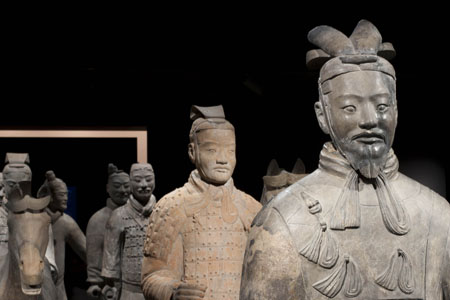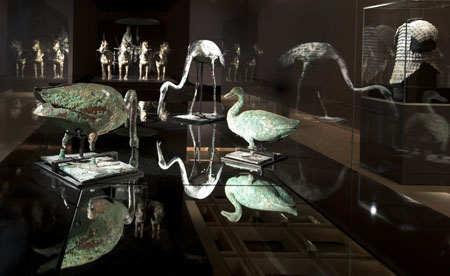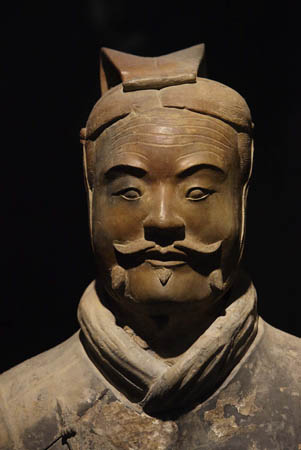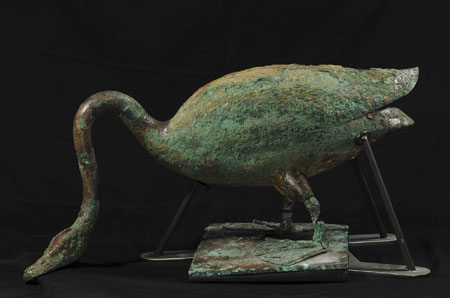Following the upheavals of the 1966–76 Cultural Revolution, ping-pong diplomacy and blockbuster exhibitions of Chinese archaeological finds were vital components of China's engagement with the world. I recall my utter amazement as I stood in the Parisian winter of 1972, an impressionable architecture student on limited time and budget, having to make a critical choice: either to turn left into the Grand Palais and look at Egypt before the Pharaohs or cross over the road to the Petit Palais where an exhibition of the recent archaeological finds of the People's Republic of China was on offer. Choosing the latter, I spent my time jostled and buoyed by the immense crowds. Struggling to understand the French text and make sense of the walls of black and white interpretive drawings, I focused on the objects, a baffling array ranging from crude Neolithic tools and weapons of the seventh millennium BCE through to fourteenth-century luxury goods. While I marvelled at the extraordinary jade funeral suit of Princess Tou Wan, it was the poetry of a gravity-defying 'Bronze of a flying horse standing by one leg on a swallow' that enchanted me.
Ten years later I was fortunate to see a similarly eclectic collection in Brussels, Trésors d'art de la Chine, 5000 BCE – 900AD. This time the range of archaeological finds included a number of the recently discovered entombed warriors of Qin Shihuang. While these pieces were no doubt the highlight of the exhibition, the manner of their presentation was not overly memorable. I recall that they were set out as disconnected figures and, with my French still not up to the task of penetrating the accompanying dense historical and technical text, I was left confounded by the story of a despotic ruler who, exercising immense vision and power, sought his own immortality.
The recent Art Gallery of New South Wales exhibition, The First Emperor: China's Entombed Warriors, opened to much fanfare and continued to generate sustained publicity relating to the collection and its historical significance. Free DVDs, multiple articles and arts programs relating to the discovery and subsequent protection of the warriors, filtered out through all media and was a constant presence on the gallery's website. A panoply of cultural events, lectures and films accompanied the exhibition, enabling visitors to be well-informed and to engage with the objects on display. So this time I, too, was better primed when I set off once again to meet representatives of Qin Shihuang's terracotta army.
Despite being on the gallery's doorstep in the middle of the week, within minutes the first three exhibition rooms were full of visitors, all intent on absorbing interpretive material and reading every piece of wall text. I chose to bypass the introductory video and moved quickly through the corridor of Gallery 1, 'Beginnings'. Here I paused momentarily to admire the undulating panorama of the receding views of the Great Wall and, by happy accident, turned and caught an unexpected glimpse through a well-positioned wall slit of the backs of the phalanx of entombed warriors glowing in the darkness of Gallery 4. Staring back across the breech was the kneeling archer, whose positioning and intensity of gaze granted a delightful moment's surprise and opportunity for intense contemplation. As the surge of visitors had not yet reached Gallery 4, but was fast swelling around the wall cases of 'Steps to empire' in Gallery 3, I moved straight on by and into the heart of the exhibition, enjoying a few minutes solitude with 'The terracotta army'.

It is a leap of faith to ask ten terracotta figures to represent the 8000 estimated to exist. The designer, architect Richard Johnson, used the proportions of the room to conjure up an atmosphere akin to the subterranean pits in which the sculptures have passed the last two millenniums. The space was divided linearly into three, separated by low, wide walls. The warriors and cavalry horses, mostly set in pairs, inhabited the central alleyway, which was closed at either end by glass barriers. The arrangement left viewers free to circulate while remaining no further than just over an arm's reach from the sculptures. The lighting focused tightly onto the figures, allowing the public just enough ambient illumination to move about safely. The gallery was blackened, its walls lined with panels of stretched Barrisol vinyl permitting only a single primary reflection. The effect was to imply depth in the space and evoke the possibility of multiple pits. This impression was further reinforced as visitors moved and circulated around the display. The lighting on the warriors was so intense that the public remained shadowy, the mirroring walls reinforcing this disparity, contributing to a sense that we visitors were mere transitory silhouettes while the warriors were the more present and substantial beings.
Statistical evidence from contemporary graves reveals that the terracotta figures of the emperor's protective army were deliberately created taller than the average citizen of his empire. In their modelling, the upper torsos are lifted, revealing the moment of an inward-held breath; the eyes are wide open to give expressions of intense serious alertness — the warriors are ready to spring into immediate action. The exhibition designer, knowing that the subtlety of intimidation inherent in each figure's pose could be lost on a tall contemporary audience, has laid a paved floor below the warriors' feet. This 'road' reinforced the recollection of the pits and simultaneously raised the figures by 150 millimetres, ensuring that most viewers were themselves peered down upon by Qin's army.
Wall text on the burial pits, the iconography of dress and detailed photographic imagery of the hairstyles were discreetly located in niches within the room. A Daoist funeral chant recorded and digitally prepared by artist Gary Warner provided an ethereal soundscape to heightening and complimenting the total experience.
The final and fifth gallery, 'The enchanted city', was no less spellbinding. It displayed recent archaeological finds from other diggings in the area around Qin's tomb complex. A photo image of the emperor's vast burial mound set in a ploughed landscape dominated the end wall. Three exquisite life-sized bronze waterfowl stood in the centre of the space over a mirror floor that reflected the tableau, transporting birds and viewer alike into the silent agricultural landscape. Down one wall were a restored suit of funeral armour and a helmet made of small limestone plaques stitched with bronze links, echoing in my mind of Princess Tou Wan's jade funeral suit.

As I made my way backwards through the galleries it became clear that the exhibits had been organised chronologically around themes. 'Beginnings' pictorially gave context to the rise of the Qin Dynasty. In 'Steps to empire' the walls were lined with showcases displaying objects ranging from ritual vessels to daily utensils. Selected to illustrate the immense skill of artisans working in bronze, precious metals, jade and earthenware from the regions surrounding the Qin state, these all belonged to the several centuries leading to the rise of the first emperor. A series of large elaborate bells commanded the centre of this room and here it was disappointing that the soundscape, which supposedly derived from these instruments, was silent on the morning of my visit. Gallery 3, 'The first emperor' evoked the political and administrative brilliance that enabled Qin to defeat, absorb and effectively rule over all his neighbours. This theme was represented by a selection of temple and palace fragments, bearing either stylised animals or intricate geometric patterns, that served to tantalise and hint at the luxury and magnificence of the world he inhabited.
As I turned to leave, passing again through Gallery 4, the room had now become very full, but since the crowd constantly circled to view the figures on all sides, it was possible to take a few minutes to be face to face with the armoured general positioned in a commanding role. This was a highlight of my visit, as I was close enough to appreciate the figure's fine features and the myriad sophisticated details of his modelling; looking beyond his shoulder, the troops and horses lined up tightly behind him formed an immensely powerful tableau.
In our media rich world, abundant references to Qin Shihuang's entombed warriors are available at the push of a button. Stories abound on their original fabrication and purpose, their finding and state of preservation. I marvel therefore at how different the curatorial and design approach at the Art Gallery of New South Wales could now be from what was academically de rigueur 30 years ago. The once ubiquitous didactic panels of diagrams and long caption text were here reduced to a minimum; and the dissociated staccato sequencing of the warriors abandoned in favour of a tight heroic composition with the kneeling archer offering dynamic protective counterpoint, both facing away from and bringing up the rear of the column.

Art Gallery of New South Wales, Sydney, Australia
The sheer theatricality of the arrangement set my thoughts racing and triggered a new set of questions:
If 700,000 people were engaged in the task of preparing Qin's tomb how many since 1974 have been engaged in the painstaking tasks of carefully revealing, preserving and popularising the find, both in China and across the planet? How many more will continue to be so occupied, in the decades and centuries to come?
What of Qin Shihuang's striving for immortality? Over the past 30 years the awareness of his deeds and enormity of his achievements have continued to flourish, spreading well beyond China to become a source of wonderment to the whole planet.
What was the environmental impact of firing the kilns to support such a monumental creative endeavour? Could the dramatic panorama of the Great Wall displayed in Gallery 1 also be revealing a severely denuded landscape, one harvested of timber for use in buildings and feeding the kilns so essential for the production of brick, bronze and terracotta?
The success of an exhibition is unique and personal to every visitor, determined partly by their prior knowledge, experience and preparedness to engage with the material displayed and partly by the presentation. Curators heighten the potential for engagement, through their selection, editing and sequencing of material to present a coherent story. The designer's role is to create a world in which the collection stimulates and entices the visitor to greater depths of knowledge, where the whole experience becomes greater than the sum of its parts.

| Exhibition: | The First Emperor: China's Entombed Warriors |
| Institution: | Art Gallery of New South Wales, Sydney, drawing on the collections of institutions including the Museum of Terracotta Warriors and Horses, the Shaanxi Provincial Archaeological Institute and the Shaanxi History Museum |
| Curators: | Edmund Capon and Liu Yang |
| Designer: | Richard Johnson |
| Venue/dates: | Art Gallery of New South Wales, Sydney, 4 Dec 2010 – 13 Mar 2011 |
